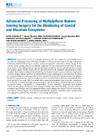Identificador persistente para citar o vincular este elemento:
https://accedacris.ulpgc.es/handle/10553/106044
| Título: | Advanced Processing of Multiplatform Remote Sensing Imagery for the Monitoring of Coastal and Mountain Ecosystems | Autores/as: | Marcello Ruiz, Francisco Javier Eugenio González, Francisco Gonzalo Martin,Consuelo Rodríguez Esparragón, Dionisio Marques, Ferran |
Clasificación UNESCO: | 3307 Tecnología electrónica | Palabras clave: | Benthic mapping multispectral and hyperspectral imagery remote sensing vegetation mapping |
Fecha de publicación: | 2021 | Proyectos: | PROCESADO AVANZADO DE DATOS DE TELEDETECCION PARA LA MONITORIZACION Y GESTION SOSTENIBLE DE RECURSOS MARINOS Y TERRESTRES EN ECOSISTEMAS VULNERABLES (ARTEMISAT-2) | Publicación seriada: | IEEE Access | Resumen: | Coastal areas are key to sustaining biodiversity, but their complexity and variability makes their analysis challenging. On the other hand, mountain ecosystems include a large percentage of the global biodiversity and their monitoring is essential, as they are especially vulnerable to climate change. In this context, remote sensing offers a cost-effective technology for the conservation of both kinds of natural areas. In this work, multispectral and hyperspectral data recorded by sensors, onboard satellites, aircrafts and remotely piloted aircraft systems (RPAS), have been used for the sustainable management of natural resources. Specifically, a multiplatform methodology has been developed to process multisensor high spatial resolution imagery and the main benefits and drawbacks of each technology have been identified. Advanced processing techniques in each stage of the methodology have been selected to provide accurate and validated benthic and vegetation maps. Two challenging ecosystems, located in Cabrera and Teide National Parks, have been selected for this study. They correspond with a coastal and a mountain island ecosystem, respectively. To address the associated challenges, the use of imagery with the maximum spatial and spectral resolution, provided by Sentinel-2, WorldView-2, CASI and Pika-L, has been considered. Results have been validated with in-situ data and by the National Parks' managers and they have shown the ability of remote sensing to accurately map both Parks when the appropriate imagery and techniques are selected. The best performance was achieved with the Support Vector Machine classifier and, in general, WorldView can be considered the most appropriate platform when factoring in cost, coverage and accuracy. | URI: | https://accedacris.ulpgc.es/handle/10553/106044 | ISSN: | 2169-3536 | DOI: | 10.1109/ACCESS.2020.3046657 | Fuente: | IEEE Access [2169-3536], n. 9, p. 6536-6549 |
| Colección: | Artículos |
Citas de WEB OF SCIENCETM
Citations
12
actualizado el 08-jun-2025
Visitas
223
actualizado el 22-feb-2025
Descargas
107
actualizado el 22-feb-2025
Google ScholarTM
Verifica
Altmetric
Comparte
Exporta metadatos
Los elementos en ULPGC accedaCRIS están protegidos por derechos de autor con todos los derechos reservados, a menos que se indique lo contrario.
